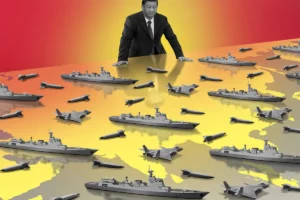Taiwan must develop ways to counter the rising threat posed by Chinese drones, the Institute for National Defense and Security Research wrote in a report commissioned by the Mainland Affairs Council.
The Chinese Communist Party (CCP) has increasingly used drones in the past few years to carry out “gray zone” operations in the airspace around Taiwan, and over the Taiwan Strait, the East China Sea and South China Sea, the report said.
Taiwan must develop measures to counter the drones, review whether existing weapons and equipment can be used to that end, and develop technologies, equipment and tactics that specifically deal with uncrewed aerial vehicles (UAVs).
The military should also enhance and expand its use of drones, and develop advanced drone technology to bolster asymmetric combat capabilities, it wrote.
The Chinese UAVs that have been spotted in the region over the past few years include the CH-4 mixed attack and reconnaissance drone; the Harbin BZK-005 high-altitude, long-range drone; the Tengden TB-001 medium-altitude, long-endurance drone; the KVD-001 tactical drone; the BZK-007 reconnaissance drone; and the Wing Loong-10 high-altitude, long-endurance drone.
The latter three first appeared in the past year, the report said.
The Wing Loong-10 first appeared over the Taiwan Strait in April last year, flying northward, it said.
The vehicle, which uses a turbojet engine for propulsion, can be fitted with a variety of weapons systems to pinpoint targets before firing from high altitude, it said.
The BZK-007 first appeared in September last year over waters to the southeast of Taiwan, the report said.
The vehicle is equipped with a satellite antenna to perform long-term reconnaissance and surveillance tasks.
“This drone has the advantage that it is cheap to build, and it can stay in the air for up to 16 hours. It has become part of the regular arsenal of China’s air force,” the report said.
The report said that China was using the incursions into Taiwanese airspace to test its drones’ long-distance flight capabilities, satellite positioning, guidance, control and automatic route planning.
The incursions are also a way for China to test Taiwan’s and Japan’s air-defense response capabilities, it said.
However, China’s military drones are mainly tasked with patrols, surveillance, reconnaissance, target calibration, battlefield assessment, communications support, air-defense suppression and logistical support, it said.
“It is clear that the CCP will use a large number of drones in military and combat missions to support its various stages of combat operations,” the report said.
“This will mean everything from intelligence gathering and communications relay to the implementation of precision strikes and serving as decoys to consume enemy air defenses,” it said.
China might also convert older fighter jets, such as the J-6 and J-7 planes, into UAVs to serve as decoys, it said.
source: taipeitimes















